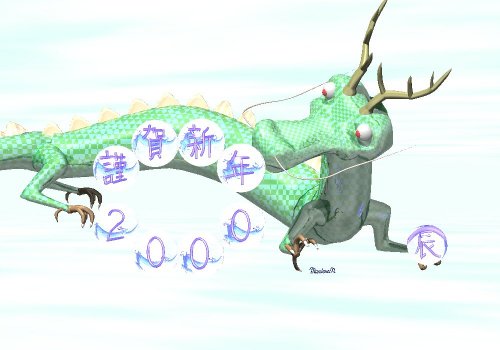 enlarge
enlarge
Happy New Year!
2004 CE, the 16th year of Heisei, is the year of the Monkey which is Saru in Japanese, and the 21st year of the sexagenary cycle, that is, Kinoe-Saru or Kou-Shin in Japanese.
January 1st, 2004 CE.. The weather forecast a few days ago said it would be cloudy, but it was clear. At Kitamoto, Kitamoso-shi, Saitama Prefecture.
Additional note.
I refered to "Tenmon Nenkan", that is, astronomical yearbook, to check this year is the Monkey, Kou-Shin or Kinoe-Saru.
The most famous monkey in the world may be Son Goku. Son Goku is Japanese pronunciation of the monkey's name. The alphabetized, Pinyin or Chinese spelling or pronunciation of his name may be Sun Wukung, Sun Wu K'ung, Sun Wukong,, Sun Wu Kong, or something like these. Son Goku on the card was caputured from the 12th episode, "Kinkaku, Ginkaku" of "Saiyuki" made by China Central Television (CCTV). Saiyuki in Japanese is also known as "Hsi-yu chi " in Chinese, or the meaninig is"Record of a Journey to the West." or called just"Monkey" in English. You may remember this program was televised in Japan more than ten years ago. I think this program is the best Saiyuki in the movies and in the TV programs. Conny Video sells DVD and VHS in Japan now. The audio is Chinese and Japanese subtitles are always on even DVD. I think this film is best, but it might be difficult to understand if you have never read the original novel. In my case, I understand some meaning of original one after watching TV. If you want to read Saiyuki, I recommend the complete translation including 100 episodes or sections. When I was young, Saiyuki translated by OOTA Tatsuo and TORII Hisayasu and published by Heibonsha was common print. These days, Saiyuki translated by ONO Miyoko and ONO Shinobu and published by Iwanami (Iwanami Bunko) is available. I am ashamed to say that I've never read Nakanos' translation yet. The contents of Japanese Saiyuki are various because many versions of original Chinese Saiyuki exists. I will read Nakano's version in futrue. As Ms. Nakano writes many study books on Saiyuki, you may be interested in them.
The face of "Kin Ga Shin Nen" or "Happy New Year" and "Kinoe Saru" or "Monkey" is Tensho, that is wellknown as the seal-engraving style of writing Chinese characters. The source is, "Mohan Shotai Jiten".
The face of "2004 CE" is Engravers old english. It is one of English "Gothic" style in European faces. Japanese "Gothic" is a kind of sans serif. The source is "Retaringu Nyumon Arufabeto"
"CE" means Common Era. AD may be more common. But AD is "anno Domini" in Latin or "in the year of the Lord" in English. I am not a Christian, then I uses CE. In case of CE, it goes after the year number, such as 2004 CE. Please see also other web sites such as http://www.radix.net/~dglenn/defs/ce.html .
The river and bank on the card is Akahori River. This place is around between Kitamoto-shi and Kounosu-shi, Saitama Prefecture.
A Happy New Year!
It was cloudy in the morning of the New Year's Day, and snowflakes were dancing in the air.
2003, 15th year of Heisei, is the year of the Sheep in the twelve zodiac signs in Chinese astrology. And ki-bi or mizu no to hitsuji in the sexagenary cycle. I used a picture of Aries, the Ram. In winter, you can watch Aries near the Pleiades ---whose Japanese name is Subaru--- which form a star cluster. But I can only two stars in the Ram's head and can not recognize the constellation profile from here. As the geographical center of Saitama prefecture is well-lighted for sky-watching, although it is not the main part of Saitama.
I edit the picture image using Paint Shop Pro. Original images are from "StellaNavigator version 6 for Windows" by AstroArts ( http://www.astroarts.co.jp/ ) . If an expert edited, it would be more beautiful.
It seems that this page is more substantial than Astronomy one....
Happy new year!
January 1st, 2002. 7:23 a.m. (JST: Japan Standard Time, GMT + 9 hrs.), about 30 minutes after the "sunrise". From Kitamoto, Kitamoto City, Saitama Prefecture. It was clouded this year.
2002, 14th year of Heisei, is the year of the Horse in the twelve zodiac signs in Chinese astrology. And Jingo or mizu no e uma in the sexagenary cycle. A picture in new year's card have nothing to do with the Horse, though, I use a photograph of the Leonids before dawn on November 19th, 2001 (Leonids 2001).
Happy new year! Happy new century!
January 1st, 2001. 6:59 a.m. (JST: Japan Standard Time, GMT + 9 hrs.) From Kitamoto pedestrian bridge on Route 17, Kitamoto City, Saitama Prefecture. The light below is the sun, and the light above is reflection to the clouds.
2001, 13th year of Heisei, is the year of the Serpent in the twelve zodiac signs in Chinese astrology. And Shinshi or Ka no to ne in the sexagenary cycle. The space ship, Discovery, in "2001: A Space Odyssey" is long and thin like a snake, isn't it? This New Year's card is a parody. The size of the Monoliths are of course modeled in the ratio, 1:4:9. I am sorry that the travel to the other planet or space trip for the public, or computer such as HAL that have real intelligence do not come true. May all of them come true someday!
The picture for the New Year's card: myShade2(R) format file mi-Nenga20001224j.lzh (about 6 MB). If you want to watch the file, please make contact with me.

The picture for the New Year's card, Dragon: myShade2(R) format file Tatsu-19991225c.lzh(Tatsu.19991225c.shd)
Update: 2004.01.02